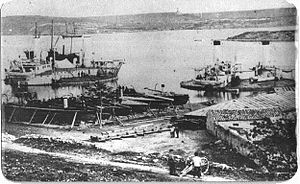- Russian monitor Novgorod
-
For other uses of "Novgorod", see Novgorod (disambiguation).

Popovkas Vice-Admiral Popov (left) and Novgorod (right) at SevastopolCareer (Russia) 
Laid down: 17 December 1871 Launched: 21 May 1873 Commissioned: 1874 Decommissioned: 4 July 1903 Struck: 1900 Fate: Scrapped 1912 General characteristics Displacement: 2,491 tons
2,671 tons at full loadLength: 30.8 m Beam: 30.8 m Draught: 3.75 m Propulsion: 8 coal-fired boilers, 6 screws, 2,000 ihp Speed: 7 knots Complement: 128[1] Armament: - 2 × 11 inch guns
- 2 × 4-pounder guns
- 16 × 37 mm guns
Armour: - Belt: 230 mm
- Deck: 60 mm
The Novgorod (Russian: Новгород) was an Imperial Russian warship. It was one of the most unusual warships ever constructed, and still survives in popular naval myth, often described as the "ugliest warship ever built". Together with her near-sister ship Rear Admiral Popov, they were affectionately called "popovkas", after their chief designer. The hull was circular (viewed from the top) intended to be a particularly stable platform for guns but proving to be almost unmaneuverable in practice.[2]
She was designed by Andrey Alexandrovich Popov of the Imperial Russian Navy, with the purpose of creating a stable platform armed with a few heavy guns, that could operate in coastal waters, and be well protected by armour plating.[2]
The perceived advantage of the circular hull form was that a shallow-draught vessel could be built with a greater displacement; a small ship could then carry the same armament as a much larger vessel with a more typical hull form.[2] For comparison, a 100-foot-long (30 m) by 13-foot-beam (4.0 m) and 13-foot-draught vessel would only displace about 2,500 tons.
The primary armament of Novgorod was two 26-ton 11-inch guns mounted on separate revolving turntables that could be moved independently or together.[2] Recoil was suppressed by a hydraulic frictional compressor, and by wedges placed in the after part of their platforms.
The ship was driven by six engines each with their own propeller shaft. Boiler and engine rooms occupied fully half of the interior hull space. The boilers were placed in two separate compartments, one on either beam.[2] Four steam launches were usually carried on deck.
Novgorod and her near-sister plunging fire. Worst though, was that the off-axis recoil of the guns would impart a centrifugal rotation to the ship.[2] In operational use, these ships would have to throw their single rudder hard over during firing, to act as "water brakes". This severely restricted the aiming and rate-of-fire of the main guns. Both ships (dubbed 'popoffkas' after their designer) served in the Danube Flotilla during the Russo-Turkish War. Both were redesignated as "Coastal Defense Armor-Clad Ships" in 1892, and relegated as storeships in 1903. They were not scrapped until 1912.
References
External links
Ironclads of the Imperial Russian NavyBroadside ironclads SevastopolS · PetropavlovskS · Pervenets
Central battery ironclads Monitors and turret ships Uragan · SmerchS · Charodeika · Admiral Lazarev · Admiral Spiridov · Petr VelikyS · NovgorodS · Categories:
- Victorian era battleships of Russia
- 1873 ships
- Battleships of the Imperial Russian Navy
- Ironclads of the Imperial Russian Navy
Wikimedia Foundation. 2010.
Look at other dictionaries:
Novgorod case — The Novgorod Case is the conventional term used in the Russian blogosphere and mass media for the controversial criminal case against Mrs. Antonina Martynova (formerly Fyodorova, née Stepanova). She is facing charges of attempted murder of her… … Wikipedia
Fairness of the Russian presidential election, 2008 — The fairness of the 2008 Russian presidential election is disputed, with election monitoring groups giving conflicting reports. Most official reports accept that not all candidates had equal media coverage and that some election monitoring groups … Wikipedia
List of Russian battleships — This is a list of Russian battleships of the period 1864 1948: BF = Baltic Fleet, BSF = Black Sea Fleet, BU = broken upEarly coastal defence ironclads(except gunboats) All of them were reclassified to bronenosets beregovoi oborony ( coastal… … Wikipedia
Russia — /rush euh/, n. 1. Also called Russian Empire. Russian, Rossiya. a former empire in E Europe and N and W Asia: overthrown by the Russian Revolution 1917. Cap.: St. Petersburg (1703 1917). 2. See Union of Soviet Socialist Republics. 3. See Russian… … Universalium
Moscow — This article is about the capital of Russia. For other uses, see Moscow (disambiguation). Moscow Москва (Russian) Federal city … Wikipedia
RUSSIA — RUSSIA, former empire in Eastern Europe; from 1918 the Russian Soviet Federative Socialist Republic (R.S.F.S.R.), from 1923 the Union of Soviet Socialist Republics (U.S.S.R.); from 1990 the Russian Federation. Until 1772 ORIGINS The penetration… … Encyclopedia of Judaism
Bibliography — INTRODUCTION The number of books dedicated to the late Union of Soviet Socialist Republics (USSR) and its successor state, the Russian Federation, is virtually incalculable. This surfeit is due to a number of factors: Russia’s geographic size and … Historical Dictionary of the Russian Federation
Russia — This article is about the current country. For other uses, see Russia (disambiguation). Russian Federation Российская Федерация Rossiyskaya Federatsiya … Wikipedia
Freedom of religion in Russia — The Constitution provides for freedom of religion, and the Government generally respected this right in practice; however, in some cases authorities imposed restrictions on certain groups. Although the constitution provides for the equality of… … Wikipedia
Rus' Khaganate — The Rus Khaganate was a polity that flourished during a poorly documented period in the history of Eastern Europe (roughly the late 8th and early to mid 9th centuries CE). [ e.g., Christian 338.] A predecessor to the Rurik Dynasty and the Kievan… … Wikipedia
